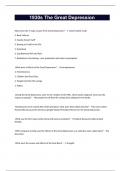Gemini wrld
Welcome to gemini world, welcome to my world of infinite knowledge and possibilities.
- 491
- 0
- 31
Community
- Followers
- Following
523 items

pathophysiology
What is the chemical transmitter released at the neuromuscular junction? Chapter 9: Which of the following cells produce new bone? a. Osteocytes b. Osteoblasts c. Osteoclasts d. Stem cells from the bone marrow - b Chapter 9: a. Norepinephrine b. GABA c. Serotonin d. Acetylcholine - d Chapter 9: What are the two types of bone tissue? a. Vascular and nonvascular b. Spongy and calcified c. Compact and cancellous d. Dense and pliable - c Chapter 9: W...
- Exam (elaborations)
- • 59 pages •
What is the chemical transmitter released at the neuromuscular junction? Chapter 9: Which of the following cells produce new bone? a. Osteocytes b. Osteoblasts c. Osteoclasts d. Stem cells from the bone marrow - b Chapter 9: a. Norepinephrine b. GABA c. Serotonin d. Acetylcholine - d Chapter 9: What are the two types of bone tissue? a. Vascular and nonvascular b. Spongy and calcified c. Compact and cancellous d. Dense and pliable - c Chapter 9: W...

Gould's Pathophysiology Chapter 1
Pathophysiology - the study of functional or physiologic changes in the body that result from disease processes. Pathology - the laboratory study of cell and tissue changes associated with disease. Homeostasis - the maintenance of a relatively stable internal environment regardless of external changes. diagnosis - identification of a specific disease through evaluation of signs and symptoms laboratory tests or other tools. More than one factor is usually required to verify a diagnosi...
- Summary
- • 6 pages •
Pathophysiology - the study of functional or physiologic changes in the body that result from disease processes. Pathology - the laboratory study of cell and tissue changes associated with disease. Homeostasis - the maintenance of a relatively stable internal environment regardless of external changes. diagnosis - identification of a specific disease through evaluation of signs and symptoms laboratory tests or other tools. More than one factor is usually required to verify a diagnosi...

Gould's Pathophysiology for Health Professional Final Exam (12-18)
What is the pathophysiology of pyelonephritis? - infection travels from ureter into kidney; pus fills fills kidney and medulla becomes inflamed What is the common sign/symptom of pyelonephritis? - lower back or FLANK pain; fever What is the pathophysiology of glomerulonephritis? - anti-streptococcal antibodies are formed, create antigen-antibody complex that lodge in glomerular capillaries What are signs and symptoms of glomerulonephritis? - periorbital edema, elevated blood pressur...
- Exam (elaborations)
- • 8 pages •
What is the pathophysiology of pyelonephritis? - infection travels from ureter into kidney; pus fills fills kidney and medulla becomes inflamed What is the common sign/symptom of pyelonephritis? - lower back or FLANK pain; fever What is the pathophysiology of glomerulonephritis? - anti-streptococcal antibodies are formed, create antigen-antibody complex that lodge in glomerular capillaries What are signs and symptoms of glomerulonephritis? - periorbital edema, elevated blood pressur...

Gould's Pathophysiology for the Health Professional FINAL
The potential unwanted, usually damaging outcomes of a primary condition or disease, such as paralysis following recovery from a stroke, are referred to as: - Sequelae The maintaining of a relatively stable internal environment by the body is called: - Homeostasis An area of dead cells resulting from a lack of oxygen, where the function of the tissue or organ may be lost, is called a(n): - Infarction The study of the physiologic (functional) changes as a result of a disease proces...
- Exam (elaborations)
- • 15 pages •
The potential unwanted, usually damaging outcomes of a primary condition or disease, such as paralysis following recovery from a stroke, are referred to as: - Sequelae The maintaining of a relatively stable internal environment by the body is called: - Homeostasis An area of dead cells resulting from a lack of oxygen, where the function of the tissue or organ may be lost, is called a(n): - Infarction The study of the physiologic (functional) changes as a result of a disease proces...

Texas Promulgated Contracts Homework
The TREC PROMULGATED CONTRACT FORMS - ARE DRAFTED BY THE BROKER-LAWYER COMMITTEE IN A LEASE WITH A RIGHT OF FIRST REFUSAL PROVISION - THE TENANT HAS THE RIGHT TO MATCH OR BETTER ANY OFFER THE LANDLORD RECEIVES TO PREVENT THE PROPERTY FROM BEING SOLD TREC promulgated contract forms provide for - third party financing, assumption seller finance a lender can withdraw the approval of a property - at any time prior to closing the third party financing addendum for credit approval i...
- Exam (elaborations)
- • 6 pages •
The TREC PROMULGATED CONTRACT FORMS - ARE DRAFTED BY THE BROKER-LAWYER COMMITTEE IN A LEASE WITH A RIGHT OF FIRST REFUSAL PROVISION - THE TENANT HAS THE RIGHT TO MATCH OR BETTER ANY OFFER THE LANDLORD RECEIVES TO PREVENT THE PROPERTY FROM BEING SOLD TREC promulgated contract forms provide for - third party financing, assumption seller finance a lender can withdraw the approval of a property - at any time prior to closing the third party financing addendum for credit approval i...

Week 7 Musculoskeletal and Neurovascular System
paraesthesia - numbness and tingling, first sign of electrolyte imbalance what are the 6 P's of an assessment for signs and symptoms of a neurovascular deficit should include... - - pain (early sign) - paraesthesia (early sign) -palpation (early sign) - paralysis (late sign) - pallor (late sign) - pulses (late sign) - capillary refill (late sign) - temperature (late sign) what do neurovascular observations provide in terms of essential information? - 1 nerve damage, 2 compromised b...
- Exam (elaborations)
- • 12 pages •
paraesthesia - numbness and tingling, first sign of electrolyte imbalance what are the 6 P's of an assessment for signs and symptoms of a neurovascular deficit should include... - - pain (early sign) - paraesthesia (early sign) -palpation (early sign) - paralysis (late sign) - pallor (late sign) - pulses (late sign) - capillary refill (late sign) - temperature (late sign) what do neurovascular observations provide in terms of essential information? - 1 nerve damage, 2 compromised b...

Ch. 22 Musculoskeletal System Subjective/Objective Data
What is the 5 components that make up questions for the subjective data for the system? - 1. Joints (pain, stiffness, swelling, heat, redness, limitation of movement) 2. muscles (pain, cramps, weakness) 3. bones (pain, deformity, trauma, fractures, sprains, dislocation) 4. functional assessment (activities of daily living) 5. self-care behaviors Joint-any problems with your joints or any pain? Location? Quality? Severity? Onset? Timing? Swelling, heat, redness and limited of movement? Pa...
- Exam (elaborations)
- • 4 pages •
What is the 5 components that make up questions for the subjective data for the system? - 1. Joints (pain, stiffness, swelling, heat, redness, limitation of movement) 2. muscles (pain, cramps, weakness) 3. bones (pain, deformity, trauma, fractures, sprains, dislocation) 4. functional assessment (activities of daily living) 5. self-care behaviors Joint-any problems with your joints or any pain? Location? Quality? Severity? Onset? Timing? Swelling, heat, redness and limited of movement? Pa...

Musculoskeletal System
musculoskeletal function - -PROTECTION of vital organs. -Provides sturdy FRAMEWORK for body structures. -Makes MOBILITY possible. -Serves as a RESERVOIR FOR IMMATURE BLOOD CELLS AND MINERALS Skeletal system - -Bone structure -Bone function -Bone growth and metabolism affected by: calcium and phosphorus, calcitonin, vitamin D, parathyroid hormone, growth hormone, glucocorticoids, estrogens and androgens, thyroxine, and insulin. - Face and neck- PROTRACTION & RETRACTION Spine- FLEXION...
- Summary
- • 15 pages •
musculoskeletal function - -PROTECTION of vital organs. -Provides sturdy FRAMEWORK for body structures. -Makes MOBILITY possible. -Serves as a RESERVOIR FOR IMMATURE BLOOD CELLS AND MINERALS Skeletal system - -Bone structure -Bone function -Bone growth and metabolism affected by: calcium and phosphorus, calcitonin, vitamin D, parathyroid hormone, growth hormone, glucocorticoids, estrogens and androgens, thyroxine, and insulin. - Face and neck- PROTRACTION & RETRACTION Spine- FLEXION...

1930s The Great Depression
What were the 7 major causes if the Great Depression? - 1. Stock Market Crash 2. Bank Failures 3. Hawley Smoot Tariff 4. Buying on Credit in the 20s 5. Dust Bowl 6. Gap Between Rich and Poor 7. Reduction in Purchasing - over production and under consumption What were 3 effects of the Great Depression? - 1.Unemployment 2. Homelessness 3. Children had Poor Diets 4. People lost their life savings 5. Hobos During the Great Depression, prior to the creation of the FDIC, when banks...
- Exam (elaborations)
- • 4 pages •
What were the 7 major causes if the Great Depression? - 1. Stock Market Crash 2. Bank Failures 3. Hawley Smoot Tariff 4. Buying on Credit in the 20s 5. Dust Bowl 6. Gap Between Rich and Poor 7. Reduction in Purchasing - over production and under consumption What were 3 effects of the Great Depression? - 1.Unemployment 2. Homelessness 3. Children had Poor Diets 4. People lost their life savings 5. Hobos During the Great Depression, prior to the creation of the FDIC, when banks...

TOEFL IBT SUMMARY 2023
abberant - abnormal, unusual, exceptional abruptly - suddenly, quickly absurd - ridiculous, irrational, nonsensical abundant - plentiful, oversufficient, copious accessible - reachable; obtainable, attainable account for - explain acknowledge - recognize, concede, admit adjacent - nearby, neighboring, adjoining advent - beginning, onset, commencement advocate - support, stand up for akin to - similar to, comparable, parallel allegiance - royalty, fidel...
- Summary
- • 1 pages •
abberant - abnormal, unusual, exceptional abruptly - suddenly, quickly absurd - ridiculous, irrational, nonsensical abundant - plentiful, oversufficient, copious accessible - reachable; obtainable, attainable account for - explain acknowledge - recognize, concede, admit adjacent - nearby, neighboring, adjoining advent - beginning, onset, commencement advocate - support, stand up for akin to - similar to, comparable, parallel allegiance - royalty, fidel...
